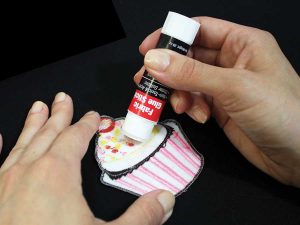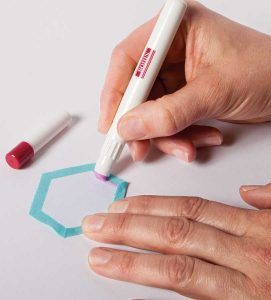There are times when it’s hard to keep something in place until you get it sewn. Of course, you can always hand-baste, but that’s tedious and time consuming. But, there’s a more slightly less conventional solution—a glue stick!
Now, it you’re a sewing purist, you may be saying to yourself—WHAT? How could someone recommend gluing something in place? But, keep in mind that the glue is only an aid, not the final attachment.
Glue sticks come in a variety of configurations—some are twistable, like a lipstick, others are shaped more like a pen with a smaller tip for more precise placement. A few brands of glue sticks are colored so that you can see where you’ve actually glued, but then as they dry, they become clear. Just be sure you choose one that’s water-soluble and temporary, unless you want permanency.
So, why would you want a glue stick in your sewing room?
- Anytime you need to alter or create a pattern and have tissue to overlap, a glue stick is handy to hold the paper.
 Placing appliqués, ribbons, laces and trims is easier when they can be secured in place prior to stitching.
Placing appliqués, ribbons, laces and trims is easier when they can be secured in place prior to stitching.- Sewing on buttons is also easier if you’re not trying to hold the button in place with one hand and stitch with the other. A small dab of glue stick on the underside of the button is all you need to secure it while stitching.
- Keeping quilt crazy patches aligned is easy with a dab of glue stick under the edges, then add your beautiful hand or machine embroidery stitches for permanency.
- Positioning a patch pocket is simple with a glue stick—just use a narrow line of adhesive near the finished pocket edges.
- And who doesn’t love trying to hold a zipper in place for a centered application? A thin line of glue along the zipper tape edges works wonders to keep it positioned for stitching.
- Mending kid’s jeans? Outline the edge of the patch wrong side with a glue stick for a sure hold. Glue is equally helpful for holding decorative patches, like on scout sashes or shirts.
 If you’re an English paper piecer, you know how tricky it is to get a sharp turned-under edge on the detailed shapes, but a thin glue stick line makes it easy peasy to fold over and hold.
If you’re an English paper piecer, you know how tricky it is to get a sharp turned-under edge on the detailed shapes, but a thin glue stick line makes it easy peasy to fold over and hold.- Struggling to keep bias binding from rippling and sliding off a curve as you stitch? Glue stick to the rescue on the wrong side of the binding, let dry and stitch ripple free.
- Applying flat bias around appliqué shapes is also a cinch with a thin line of glue stick behind. Stained glass appliqué has never been easier, and that pesky bias end can be tucked under with ease.
- When working with fabrics like vinyl, laminates or leather where pin holes last forever, a glue stick is a must for holding anything and everything in place for stitching, pin-free.
- Matching plaids and stripes along seamlines is easy if you glue the seam first, as opposed to pinning. There are no worries about accidentally hitting a pin while stitching or having the seam shift just enough to be noticeable.
- Matching adjacent seamlines, like on pieced quilts, or with garment detailing like yokes, is simplified with the help of a bit of glue, too. Again, no pins to worry about, and no shifting as you sew.
- Fusible interfacing is a real timesaver, but it doesn’t work for all fabrics. However, with your handy glue stick you can handle any sew-in interfacing with ease. Simply run a line of glue along the seam allowance outer edges and position the interfacing atop. The glue stick line secures the interfacing in place until it’s caught in the sewn seam.
- If you’re making a garment and no one is around to help you mark the hem, grab the glue stick and temporarily hold the hem in place while you try it on. Adjust the length as needed and re-glue for a final check before stitching.
Helpful Hints
- To use your glue stick to best advantage, allow the glue to dry before sewing. If you’re short on time, use a dry iron to speed the drying process.
- Can you stitch through a glued area without issue? In most cases, yes, as long as the glue is dry. A non-stick needle is recommended anytime you’re stitching through an area with any kind of adhesive, whether fusible or glue.
Remember that fabric glues are also available in forms other than sticks and can be used for all the same purposes mentioned above. Now that you’re armed with this knowledge, you should be able to handle any sticky situation that arises!
~Linda Griepentrog
Linda is the owner of G Wiz Creative Services and she does writing, editing and designing for companies in the sewing, crafting and quilting industries. In addition, she escorts fabric shopping tours to Hong Kong. She lives at the Oregon Coast with her husband Keith, and two dogs, Yohnuh and Abby. Contact her at gwizdesigns@aol.com.






